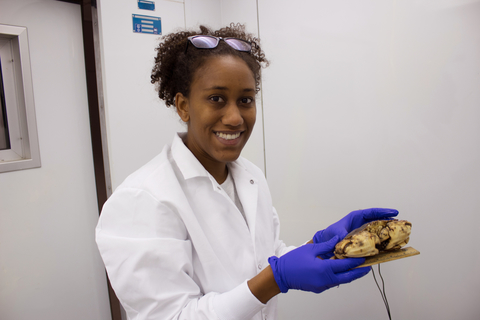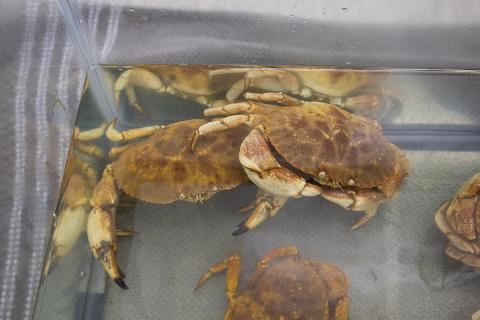UMCES Next Generation: Amanda Lawrence
 What is the focus of your research?
What is the focus of your research?
My research is working to understand how we can identify when male Jonah crabs, an understudied species of crab, become sexually mature. Specifically, I am looking at hormone levels and sperm content and relating it to the crab’s size to help policy makers establish size limits for fishermen who collect the crabs. We are also trying to understand what kind of hormone levels are found in sexually mature crabs and if that is related to the size of crabs.
How will it make a difference?
Understanding the size at which the Jonah crab becomes sexually mature is important because it can help inform management decisions and size limits for crabs that are harvested. By understanding the biology behind their size and sexual maturity, fishermen can have guidelines on which crabs to release back into the wild so the crustaceans can reproduce and sustain the population.
What influenced your career path in science?
I took an environmental science course in high school, and I found the topics we talked about in class, like climate change and ocean acidification, really interesting. I felt like these issues were really important so I decided that I wanted to work, either in policy or research, to help conserve the environment.
Why did you choose to study with your mentor at UMCES?
I was a Living Marine Resources Cooperative Science Center (LMRCSC) intern at the Institute of Marine and Environmental Technology working in Sook Chung’s lab and really liked the research I was doing. I got along really well with Dr. Chung and she helped me a lot with my writing and critical thinking, so I decided to apply for the Marine Estuarine Environmental Sciences (MEES) program and continue my research in her lab.
 What is an experience that stands out most to you about your time at UMCES?
What is an experience that stands out most to you about your time at UMCES?
There are a lot, but the MEES colloquium is definitely a stand-out moment. It is one of the opportunities we as students have to learn about all the research going on within UMCES and talk to the other graduate students at the different labs.
What is the most important thing people can do to help the environment?
Being generally conscious of your footprint. Small steps in everyday life, like recycling when you can or opting out of using single-use plastics, add up and become habits in the long run. Always think and be conscious of how your actions may affect the planet.
Do you have advice for kids in the next generation who are interested in STEM fields?
Take advantage of as many opportunities that come your way as you can. Whether it’s an internship or a volunteer experience, getting a chance to experience something is the only way you can tell if you like it or not. Accepting an internship at IMET is what helped me figure out what path I wanted to take in my scientific career.
Have you received a scholarship, grant, travel award or gift from a donor? What did it allow you to do and why was that important?
I was most recently awarded the Knauss Marine Fellowship Program, where I will spend a year in Washington, D.C. learning how environmental policy works and how research is used to inform policy. NOAA’s Living Marine Resources Cooperative Science Center currently provides the funding for my tuition and living expenses while I study at IMET. I was also a National Institute of Standards and Technology Fellow, where I was an intern and got to experience a government lab, which was a great opportunity for picking up scientific techniques outside of my research interest that I wouldn’t have otherwise learned.
What are your future plans?
I’m open to any new opportunities that come my way, but I will be spending next year in D.C. for my Knauss Fellowship. After the fellowship, I may continue my career in environmental policy or return to more research-based work.